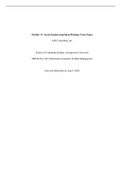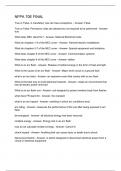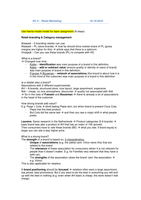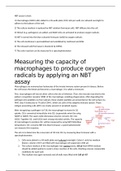Problem sensing: Sensing worries and stress.
Problem structuring: Comparing, contrasting, and evaluating problem formulations.
Problem resolving: Reanalysis of structured problems to reduce errors.
Problem unsolving: Abandonment of a solution due to wrong formulation.
Problem dissolving: Abandonment of a problem due to wrong formulation.
Policy problems:
Interdependency: Affect problems in other areas.
Subjectivity: External conditions are selectively defined, classified, and evaluated.
Artificiality: They are only created when people make judgements about the desirability of
changing a situation.
Instability: The problems and solutions are constantly changing.
Types and typologies of (policy) problems:
1. Ill-structured vs. Well-structured
Ill structured: There is no clear path to a solution. Often have multiple possible solutions and
often require innovative or unconventional approaches.
Well-structured: There is a clear and known procedure or method to reach a solution.
2. Structured vs. Unstructured
Structured: This is like well-structured problems, there is a clear method or pathway to a
solution.
Unstructured: This is like ill-structured problems, there is a lack of a clear path or method,
and there may not even be a clear definition.
3. Distributive, Re-distributive, Regulatory and Coordination.
Distributive: The allocation or distribution of resources across various groups without taking
away from other groups.
Re-distributive: Taking resources from one group and giving them to another, often with the
intention of achieving social equity.
Regulatory: Policy problems that stick to norms, standards, or rules. They often involve
having limits or boundaries for actions and behaviors in society.
Coordination: Policy problems that aim to guide a group of actors, organizations, etc. to a
common goal.
4. Wicked vs. Tame
Wicked: Complex, ill-defined, and multifaceted. They are hard to define, harder to solve and
solutions may have unintended consequences.
Tame: They are possibly complex but have a well-defined problem statement and can be
solved through linear processes. The solution often solves the problem without major
unintended consequences.
Rittel and Weber:
1. No definitive solution.
2. No stopping rules.
3. Solutions are not good or bad, true or false.
4. There is no test of solution.
5. One shot operation.
6. Enumerable set of possible solutions.
7. Every problem is unique.
, 8. Every problem is a symptom of another problem.
9. The existence can be explained in many ways.
10. There is no public tolerance of failed experiments.
Degree of complexity of elements, subsystems, and interdependencies.
Degree of uncertainty in relation to risks, consequences, and changing patterns.
Degree of divergence and fragmentation in viewpoints, values, and strategic intentions.
→ This becomes active in combination with:
- Power: social and political control exercised by certain actors.
- Political interest: attention, motivation, policy preferences, and goals of an actor.
Before the welfare state The Industrial Revolution
Feudal society: before industrialization, The social question: The industrial mode of
urbanization, and the advent of capitalism. production leads to high unemployment
- Cyclical and seasonal fluctuations in and mass migration to the city (Poor work
poverty. and living circumstances).
- Support provided by family, church,
local communities, and charities. A paradigm shift in the welfare provision:
- State provided “outdoor relief” Elites realized that mass poverty was a
(social assistance or welfare social problem.
provided while people remain in - Outrages over workers work and
their own homes or communities) to living conditions.
the deserving poor. - Industrial workers organized in
- State provided “indoor relief” unions.
(workhouses, almshouses, etc. - Social unrest threatened the social
which came with conditions like order, hindered economic
mandatory work or strict rules) to development.
the undeserving poor. Welfare state: social responsibility for
socially induced conditions of dependency.
Poverty is the product of laziness and sins.
Poverty is the outcome of a set of social
processes associated with industrialization
and economic development.
Post-war period Rediscovery of Poverty
Golden age of welfare (state is responsible Persistence of the problem, despite social
for the necessities of welfare). policies because of upward trend in income
inequality and poverty across the western
Extension of the social policies for a world (globalization, liberalization,
comprehensive supply of the right to social economic crisis, etc.).
security: most notably retirement funds and
social assistance. Responses to the welfare dysfunction:
- Privatization (company private)
Poverty was considered solved. - Retrenchment (reduce costs)
- Flexibilization
Poverty persists
Problem structuring: Comparing, contrasting, and evaluating problem formulations.
Problem resolving: Reanalysis of structured problems to reduce errors.
Problem unsolving: Abandonment of a solution due to wrong formulation.
Problem dissolving: Abandonment of a problem due to wrong formulation.
Policy problems:
Interdependency: Affect problems in other areas.
Subjectivity: External conditions are selectively defined, classified, and evaluated.
Artificiality: They are only created when people make judgements about the desirability of
changing a situation.
Instability: The problems and solutions are constantly changing.
Types and typologies of (policy) problems:
1. Ill-structured vs. Well-structured
Ill structured: There is no clear path to a solution. Often have multiple possible solutions and
often require innovative or unconventional approaches.
Well-structured: There is a clear and known procedure or method to reach a solution.
2. Structured vs. Unstructured
Structured: This is like well-structured problems, there is a clear method or pathway to a
solution.
Unstructured: This is like ill-structured problems, there is a lack of a clear path or method,
and there may not even be a clear definition.
3. Distributive, Re-distributive, Regulatory and Coordination.
Distributive: The allocation or distribution of resources across various groups without taking
away from other groups.
Re-distributive: Taking resources from one group and giving them to another, often with the
intention of achieving social equity.
Regulatory: Policy problems that stick to norms, standards, or rules. They often involve
having limits or boundaries for actions and behaviors in society.
Coordination: Policy problems that aim to guide a group of actors, organizations, etc. to a
common goal.
4. Wicked vs. Tame
Wicked: Complex, ill-defined, and multifaceted. They are hard to define, harder to solve and
solutions may have unintended consequences.
Tame: They are possibly complex but have a well-defined problem statement and can be
solved through linear processes. The solution often solves the problem without major
unintended consequences.
Rittel and Weber:
1. No definitive solution.
2. No stopping rules.
3. Solutions are not good or bad, true or false.
4. There is no test of solution.
5. One shot operation.
6. Enumerable set of possible solutions.
7. Every problem is unique.
, 8. Every problem is a symptom of another problem.
9. The existence can be explained in many ways.
10. There is no public tolerance of failed experiments.
Degree of complexity of elements, subsystems, and interdependencies.
Degree of uncertainty in relation to risks, consequences, and changing patterns.
Degree of divergence and fragmentation in viewpoints, values, and strategic intentions.
→ This becomes active in combination with:
- Power: social and political control exercised by certain actors.
- Political interest: attention, motivation, policy preferences, and goals of an actor.
Before the welfare state The Industrial Revolution
Feudal society: before industrialization, The social question: The industrial mode of
urbanization, and the advent of capitalism. production leads to high unemployment
- Cyclical and seasonal fluctuations in and mass migration to the city (Poor work
poverty. and living circumstances).
- Support provided by family, church,
local communities, and charities. A paradigm shift in the welfare provision:
- State provided “outdoor relief” Elites realized that mass poverty was a
(social assistance or welfare social problem.
provided while people remain in - Outrages over workers work and
their own homes or communities) to living conditions.
the deserving poor. - Industrial workers organized in
- State provided “indoor relief” unions.
(workhouses, almshouses, etc. - Social unrest threatened the social
which came with conditions like order, hindered economic
mandatory work or strict rules) to development.
the undeserving poor. Welfare state: social responsibility for
socially induced conditions of dependency.
Poverty is the product of laziness and sins.
Poverty is the outcome of a set of social
processes associated with industrialization
and economic development.
Post-war period Rediscovery of Poverty
Golden age of welfare (state is responsible Persistence of the problem, despite social
for the necessities of welfare). policies because of upward trend in income
inequality and poverty across the western
Extension of the social policies for a world (globalization, liberalization,
comprehensive supply of the right to social economic crisis, etc.).
security: most notably retirement funds and
social assistance. Responses to the welfare dysfunction:
- Privatization (company private)
Poverty was considered solved. - Retrenchment (reduce costs)
- Flexibilization
Poverty persists











